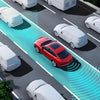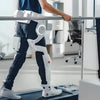Optimizing Smart Buildings with TOF and Occupancy Sensor Integration

With the rapid evolution of smart buildings and automation technologies, the integration of TOF (Time of Flight) sensors and occupancy sensors is emerging as a key innovation. Together, these technologies enhance energy management, optimize space usage, and improve overall efficiency in smart buildings. In this article, we will explore how the combination of TOF technology and occupancy sensors creates a more efficient and responsive smart building system.
What is TOF (Time of Flight) Technology?
TOF sensors are highly precise devices that calculate the distance between the sensor and an object by measuring the time it takes for a light signal to bounce back. By emitting light pulses and analyzing the return signals, TOF technology creates depth maps that help detect objects, movements, and distances in real-time. This technology is particularly useful in fields requiring accurate spatial awareness, such as object detection, gesture recognition, autonomous driving, and robotics. The precise depth measurement capability of TOF sensors allows them to track movement, measure distances, and even capture detailed 3D images.

What are Occupancy Sensors?
Occupancy sensors are devices that detect the presence or absence of people in a specific area. These sensors are integral to smart building systems, providing automation for energy management by controlling devices such as lighting, heating, ventilation, and air conditioning (HVAC). Occupancy sensors typically utilize one of three technologies:
- Infrared (IR) Sensors: These sensors detect body heat to determine occupancy. Passive Infrared (PIR) sensors are most common in detecting human presence.
- Ultrasonic Sensors: They use high-frequency sound waves to measure the time it takes for the sound to return after bouncing off a surface, detecting movement and occupancy.
- Microwave Sensors: These emit electromagnetic waves and detect changes in signal reflections, suitable for larger spaces and dynamic environments.
Occupancy sensors help optimize energy consumption by ensuring that systems are only active when people are present, thus reducing waste and lowering costs.
How TOF Technology and Occupancy Sensors Work Together
-
Precise Spatial Awareness and Occupancy Detection
When TOF sensors are combined with occupancy sensors, they work in tandem to offer highly accurate detection and tracking. TOF sensors capture detailed depth information, allowing them to detect the position and movement of individuals within a space. Occupancy sensors can then trigger energy-efficient actions, like turning lights on or off, based on the actual occupancy of a room. This dual integration ensures seamless operation and maximizes space utilization. -
Energy Optimization
The integration of TOF sensors and occupancy sensors in smart buildings offers remarkable energy savings. TOF sensors can track the exact location and movement of people, while occupancy sensors ensure that devices like lighting and HVAC systems only activate when a space is occupied. This prevents unnecessary energy consumption, making buildings more energy-efficient and contributing to sustainability goals. -
Enhanced User Experience
By combining these two technologies, smart building systems can offer a more intuitive and responsive experience. For example, in smart homes, TOF sensors enable gesture-based control to adjust lighting or temperature, while occupancy sensors ensure that settings adjust automatically based on room occupancy. This results in a more personalized and efficient user experience.
Practical Applications of TOF Technology and Occupancy Sensors
-
Energy Efficiency in Smart Buildings
The synergy between TOF technology and occupancy sensors plays a crucial role in optimizing energy consumption in smart buildings. With real-time data from TOF sensors, systems can dynamically adjust lighting, air conditioning, and other devices based on the actual presence of individuals. This improves operational efficiency and reduces energy waste. -
Security and Automation
The combination of TOF sensors and occupancy sensors can also enhance security measures. For instance, TOF sensors can detect unauthorized movement within a space, while occupancy sensors determine whether the space is occupied. If suspicious movement is detected, the system can automatically activate alarms or security measures, providing faster and more accurate responses. -
Smart Homes and Automation
In smart homes, the integration of TOF sensors and occupancy sensors offers seamless control over home automation systems. TOF technology enables users to control devices with natural gestures, while occupancy sensors detect when a room is in use to optimize energy consumption. This allows users to enjoy an efficient and comfortable living environment.
Future of TOF Technology and Occupancy Sensors in Smart Buildings
As smart building systems continue to evolve, the role of TOF sensors and occupancy sensors will become even more integral. The future of smart buildings will focus on advanced integration, with TOF sensors providing detailed, real-time spatial data and occupancy sensors optimizing energy usage in response to actual occupancy. With continued technological advancements, these systems will offer increasingly precise control, further enhancing user experiences, energy efficiency, and automation capabilities.
Conclusion
The integration of TOF sensors and occupancy sensors creates a powerful combination for the future of smart buildings. By offering precise spatial awareness, real-time occupancy detection, and intelligent energy management, these technologies significantly improve the operational efficiency and user experience of smart spaces. As smart buildings continue to grow in importance, the combination of TOF technology and occupancy sensors will play a pivotal role in shaping the next generation of intelligent, sustainable, and user-centric environments.
This integration not only enhances the quality of life for occupants but also contributes to a more energy-efficient, secure, and cost-effective future.
XT-M120 Series 3D ToF LiDAR Solid-State 120 Lines 20m Distance Anti-Strong Light
After-sales Service: Our professional technical support team specializes in TOF camera technology and is always ready to assist you. If you encounter any issues during the usage of your product after purchase or have any questions about TOF technology, feel free to contact us at any time. We are committed to providing high-quality after-sales service to ensure a smooth and worry-free user experience, allowing you to feel confident and satisfied both with your purchase and during product use.
-
Posted in
XT-M120





